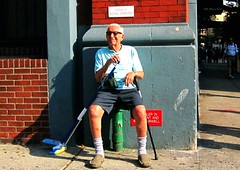You notice them everywhere in Manhattan, but perhaps particularly in a slightly out-of-the-way neighborhood such as the East Village — middle-aged or older New Yorkers who look as if they have remained in the city that doesn’t sleep way past the limits of insomnia or common sense.
They seem a little lost in this International House of Cupcakes, among i-Stoned youth, galvanized immigrants, packed bars, and cafés where the music is always played at a volume whose message might as well be posted on a notice board outside — Adults Permitted, But Youth Preferred.
Aging is a delicate, unrewarding business at best, and some people — as a result of genes, outlook, resolution, and money — manage it better than others. To judge by the relative lack of oldsters in the East Village (anyone over 40 is a rarity on the streets after 9 p.m., and most of those are either homeless, comatose, or possibly dead), it’s obvious that this is one of the more trying places in which to grow old. Those who hang on must also confront the irony of living in an era in which they are constantly scolded that it is within their power to remain “young,” while being made to feel ancient almost all the time.
Immigrants — South Asians in particular, perhaps — adapt better, because they are not entirely in thrall to youth culture. Latinos too, in a different way. In fact, any group which adheres, even loosely, to a traditional belief system is likely to be less troubled by aging than, say, a single, white, agnostic woman who wakes up one morning and realizes she might be getting too old for the bar scene. What does she do then? Head for the suburbs? Invest in a new TV and stay in at night with Netflix? Or just brazen it out? (The best course, but one that requires a certain strength of character.)
Journalists generally don’t write about growing older in a hip young neighborhood because even hinting at an interest in the topic is tantamount to an admission that they may be getting a little long in the tooth themselves. Yet age apartheid is one of the most salient and least discussed aspects of life in the East Village. In his disastrous but unforgettable mayoral campaign of 1969, Norman Mailer suggested turning the East Village into an autonomous zone, leaving the acid-heads and “freaks” to run the place, rather as the Danes did with the Christiania section of Copenhagen a couple of years later. It never happened, but in a way the neighborhood is as unbalanced as if it had.
East of Third Avenue, the East Village is mostly Kiddie Town, and it has been for a long time now. It’s not a part of the city middle aged people tend to move into. It would be more accurate to say it’s one from which some certain middle aged (and older) people have failed to move out. The reasons range from genuine love for the place, and identification with its values, to simple economics — rent stabilization laws and, once a few years have gone by, a reluctance to leave the city coupled with the inability to find an affordable apartment elsewhere.
Predictably, there’s a price to be paid that goes beyond the savings on rent. Recently, a stylish, attractive artist in her mid-60’s who spends half the year in France and half the year here, told me that in Paris people still look at her, that she is made to feel like “a real person.” But in the East Village (which she loves), she says she is “invisible,” a spectator who must content herself with being ignored and sometimes bumped into on the street as if she were not physically present at all.
One reason for the difference between New York and Paris is that in many Continental cities, the service jobs which here belong exclusively to people under 30 (if that) are taken up, and guarded zealously, by the middle aged. In New York, whether it’s a bank, café, gym, restaurant, boutique, supermarket or book store, generally speaking, the young wait on the young. There are downsides to the Continental system, but it does mean that an age-mix is built into enough institutions to keep older people from feeling like aliens from a planet no one wants to hear about. It also reduces the chances that you will find yourself discussing your life savings with a bank manager whose role model is David Beckham.
As a white New Yorker, I sometimes find myself slightly envious of certain immigrants I see here. I know many of them have it hideously hard, far more so than I ever did, and I certainly don’t envy them all. Nonetheless, many seem much more at peace with themselves than the privileged young Americans — the ones ideally suited to live in this neighborhood at this time – who often appear to suffer from a corrosive self-doubt and lack of identity which they mask with loud displays of self-assertion, of having a “good time,” and of frantically “connecting” with anyone and everything.
Ironically, they may be the biggest victims in a neighborhood where age apartheid is effected not by law, but by multiple codes, barriers, gates, and moats filled with invisible alligators whose existence no one can definitively prove but which no one can fail to notice, either. After all, where’s the joy in being young if there’s a dearth of older people around to remind you that young is what you are?






